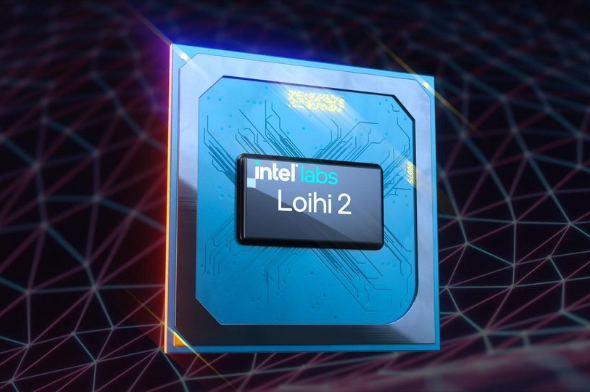Connection to DriversCloud Create a DriversCloud.com account Reset your DriversCloud.com password Account migration
Intel unveils Loihi 2, a second generation neuromorphic processor
A completely new architecture that proposes to replicate the functioning of a real biological brain.
In the course of 2017, Intel launched its first neuromorphic processor called Loihi. The idea then was to change the optics compared to traditional processors. Today, the American is moving up a gear by already presenting the second generation of this new architecture, soberly named Loihi 2. The chip is resolutely modern by using the latest engraving process, the Intel 4, which corresponds more or less to a lithographic engraving 7 nm EUV, but which is still in pre-production phase.
As we said, a neuromorphic processor must, on paper, copy the functioning of a biological brain and this translates into a system of communication between the cores that is very different from what we know on our Core, Pentium and Ryzen. Here, we are closer to the principle of synapses and Intel emphasizes that it is not a question of synchronizing to a clock frequency: we are talking about anevent-based architecture where exchanges are carried out at the moment when the data is ready to be processed. In the long term, the activity of a neuromorphic processor is therefore very variable, again this corresponds to what can be found in a biological brain.
In order to emphasize the interest of such a processor, Intel undertakes a daring comparison: it places, one in front of the other, a Calopsitte parakeet - a small bird native to Australia - and a recreational drone. Thus, the American specifies that the brain of the bird weighs only 2,2 grams for a power of 50 mW and important faculties of learning: it is able to reproduce some words of English or to learn how to handle a glass for example. On the contrary, the controller of the recreational drone cannot "learn" anything while it weighs 40 grams and its power is 18 000 mW.
In practice, Loihi 2 obviously brings a lot of novelties compared to Loihi 1. Intel specifies, for example, that the second generation embarks 1 million "neurons" when the first had to be satisfied with 128,000, and this, while the size of the die is singularly reduced: we go from 60 mm² for Loihi 1 to only 31 mm² for the successor. A successor whose processing capacity can be up to 10 times greater than that of the first generation. On the other hand, Mike Davies, Director of Intel's Neuromorphic Computing Lab, points out that the very low power consumption of Loihi 1 has not really been improved, as Intel has concentrated its efforts on the management of inputs and outputs allowing a bandwidth four times higher on the new chip
Intel recognizes, however, that the commercial distribution of Loihi 2 chips is not planned in the immediate future. The American specifies that the members of the INRC - or Intel Neuromorphic Research Community - will have access to Loihi 2 thanks to two systems of test: first Oheo Gulch equipped with a single chip and, in the second time, Kapoho Point and its eight processors.







